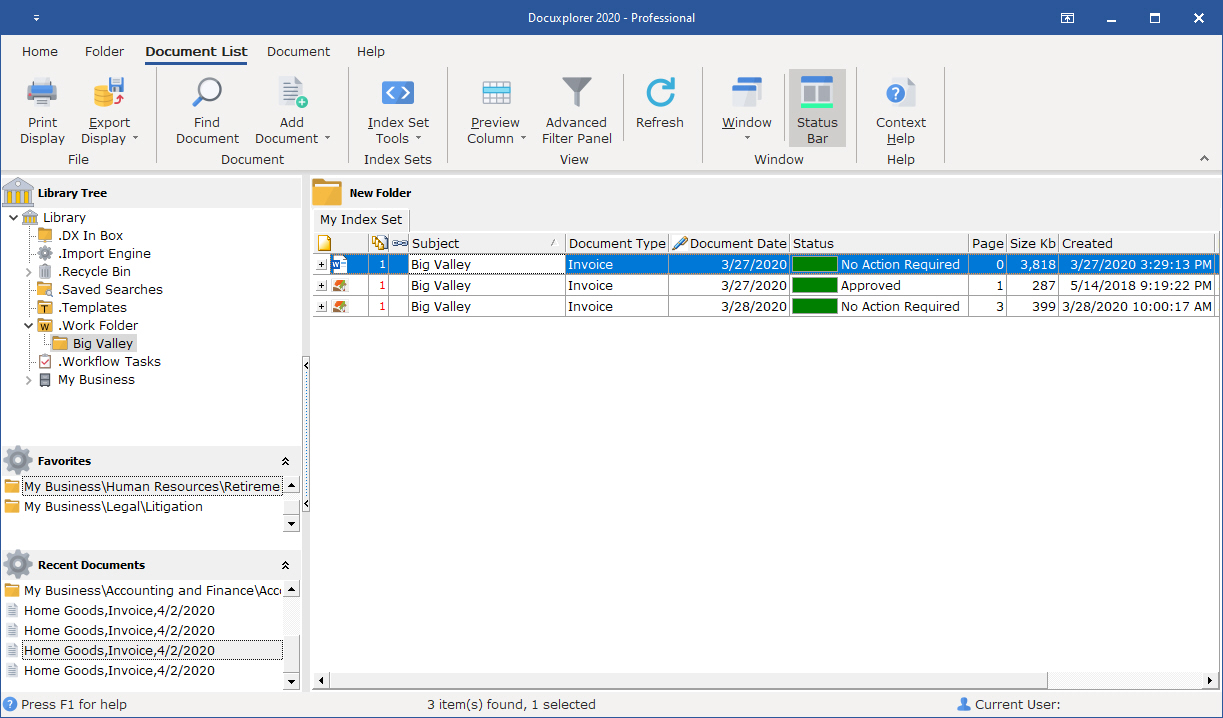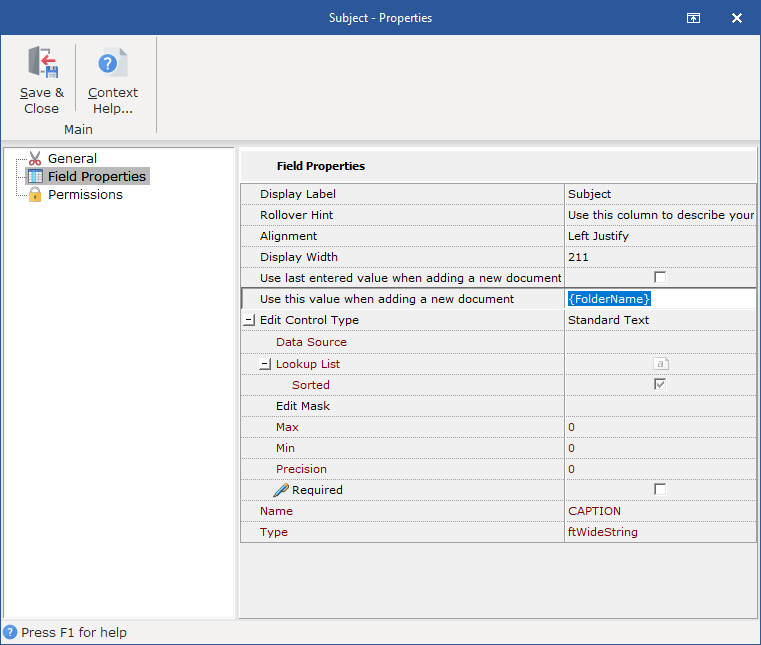
This Help topic refers to the following editions:
þ Enterprise þProfessional
Auto-Indexing Variables are used to automatically populate index fields and Find Document requests with data based on one of the following variables.
{Today} - Current Date and Time
{Date} - Current Date
{Time} - Current Time
{ComputerName} - The computer's name as defined in Operating System under System Properties
{NetworkUserName} - The Windows or Network User name
{LoginName} - User name used when login in to Docuxplorer.
{FolderPath} - The full path name where the document is created
{CabinetName} - The name of the Cabinet where the document is created
{DrawerName} - The name of the drawer where the document is created
{FolderName} - The name of the folder where the document is created
{ParentFolderName} - To be used when a document is added to a subfolder. The field will be populated with the name of the parent object. When adding a document to a folder whose parent object is a Drawer, the Drawer name will be used to populate the field. To access other folders that are the parent of the current folder use the format {ParentFolderName-1}, {ParentFolderName-2}, {ParentFolderName-3} etc to access each folder up the library tree.
{+#+} # - represents a numeric value between -2147483648 and 2147483647 which would be incremented by 1 each time a new document is added. No spaces should be placed between {+ and +}. Correct example {+101+} would produce 102 as it’s next value. This could be used as a serial number or Bates number stamped on a document. Incrementing numbers are associated with an Index Set. The number will increment on any documents added to the Library that are associated with that Index Set.
{Date,MM, DD, YY} - this auto-indexing
variable is used to create an automatically incrementing
date field. Leap years will automatically be determined and properly
handled. This variable can be used for either a date or text field.
The variables that can be modified are:
DATE, TODAY = the current systems date, you can also enter any valid date e.x. 12/2/2020
MM = the numbers of months to add or subtract from the current date
DD = the numbers of days to add or subtract from the current date
YY
= the numbers of years to add or subtract from the current date
For example, for a field that will automatically populate with
a purge date that is seven year from the date of entry, the statement
would like this {Date+0,0,7} = today's date plus 7 years. A purge
date query could then be initiated to display documents to be
purged in a date range.
{ GUI-UniqueID} is a globally unique identifier, automatically generated by the system. It is useful for identifying documents.
{FileName} The name of the imported file with out the file extension
{FileType} The imported file's extension
{FilePath} The imported file's path
DocuXplorer has the ability to read the extended file attributes of different file types. This information can then be used to auto populate index fields. Each applications support a different number of these extended file attributes so its not possible to list every attribute here. However, if you import a document and view it via "Open Document Viewer" and select File | Properties you will see a list of extended file attributes that have been assigned a value for the selected document. Below are a few of the basic attributes that most application populate and control. See the help information from these application on how to control these attributes further.
{Title} - will fill field with data found in the Title field
Author} - will fill field with data found in the Author field
{Subject} - will fill field with data found in the Subject field
{Keywords} - will fill field with data found in the Keywords field
{Comments} - will fill field with data found in the comments field
Outlook Document Auto-Indexing Variable - the following auto-indexing variables are specific to saving emails and tasks from Outlook and can significantly reduce the amount of indexing required for an email document with any Index Set. These auto-indexing variable will extract the To, From, and Subject data of an email to populate DocuXplorer fields.
{ EmailTo} - will fill a field with the To email address associated with an Outlook email message
{ EmailFrom} - will fill a field with the From email address associated with an Outlook email message
{ EmailSubject} - will fill a field with the Subject data associated with an Outlook email message
{EmailSentOn} - will fill the field with the Sent Date of an Outlook email message
{EmailReceivedTime} - will fill a field with the time the Outlook email message was received
{EmailAttachmentCount} - will fill a field with a integer indicating the number of attachments associated with the email
{ TaskSubject} - will fill a field withe Subject data associated to an Outlook Task
{ TaskPercentComplete} - will fill a field with the percent completed as displayed on the Outlook Task Screen
{ TaskDueDate} - will fill a field with the Task Due Date as displayed on the Outlook Task Screen
{ TaskStartDate} - will fill a field with the Task Start Date as displayed on the Outlook Task Screen
{ TaskDateCompleted} - will fill a field with the date the Outlook Task status has been Completed
Enable extended file properties for Auto Index values
When enabled via Tools | Options | Workstation | Import Document Settings
To automatically fill a field with data using an Auto-Index Variable;
Right click the Field on the Column Header Bar
Select Field Properties from the drop down list
Click on the item - "Use this value when adding a document"
Enter the variable and click OK in the text field
Click Ok and close the Field Properties dialog box
Tip:
To use Variables when adding a new document, the Folder the document is being added to, must be defaulted to the Index Set containing the Variable. The defaulted Index Set must have a field which has its "Use this value when adding a document" property set to automatically enter one of the listed Variables.
These variables are a powerful feature of DocuXplorer and allow you to significantly reduce the time it takes to index a document.
Some examples of the use of Variables in an Index Set are:
A business that stores documents based on a client, project or patient name
A business that stores documents based on multiple indexes such as client, location, and project
In a situation where your business deals with the documents based on client or patient name you would create a Cabinet called Clients with Drawers based on an alpha grouping such as A to D. In the following example for a Law, Accounting, Financial Services Firm or Health Care Facility, Folders would be based on a client name such as Abacus Shutters, Abrams Financial Management, etc.

The screen above used the {FolderName} variable to automatically populate the Client field with the client name based on the Folder
To automatically fill the Client field with the FolderName;
Right click the Client Field on the Column Header Bar
Select Field Properties from the drop down list
Select the item - Use this value when adding a document
Enter the variable {FolderName}
Click Ok and close the Field Properties dialog box

The following example is a Real Estate Management company that deals with multiple properties in multiple locations.
In the Library a Cabinet is created for management documents
A Drawer is created for each city in which the client has properties
A Folder is created for each property in a City location Drawer
An Index Set is created with Fields for City, and Property each containing variables to auto-index fields associated with a document.

In this example the RE Management firm can add documents to the property folder with some fields being automatically indexed and have other fields that are populated with index data specific to the document, in this case the Subject and Doc. Type field.
Notice also that the Document Text Field is being used to provide memo notes on a document that are easily viewable by any user with access to this folder.